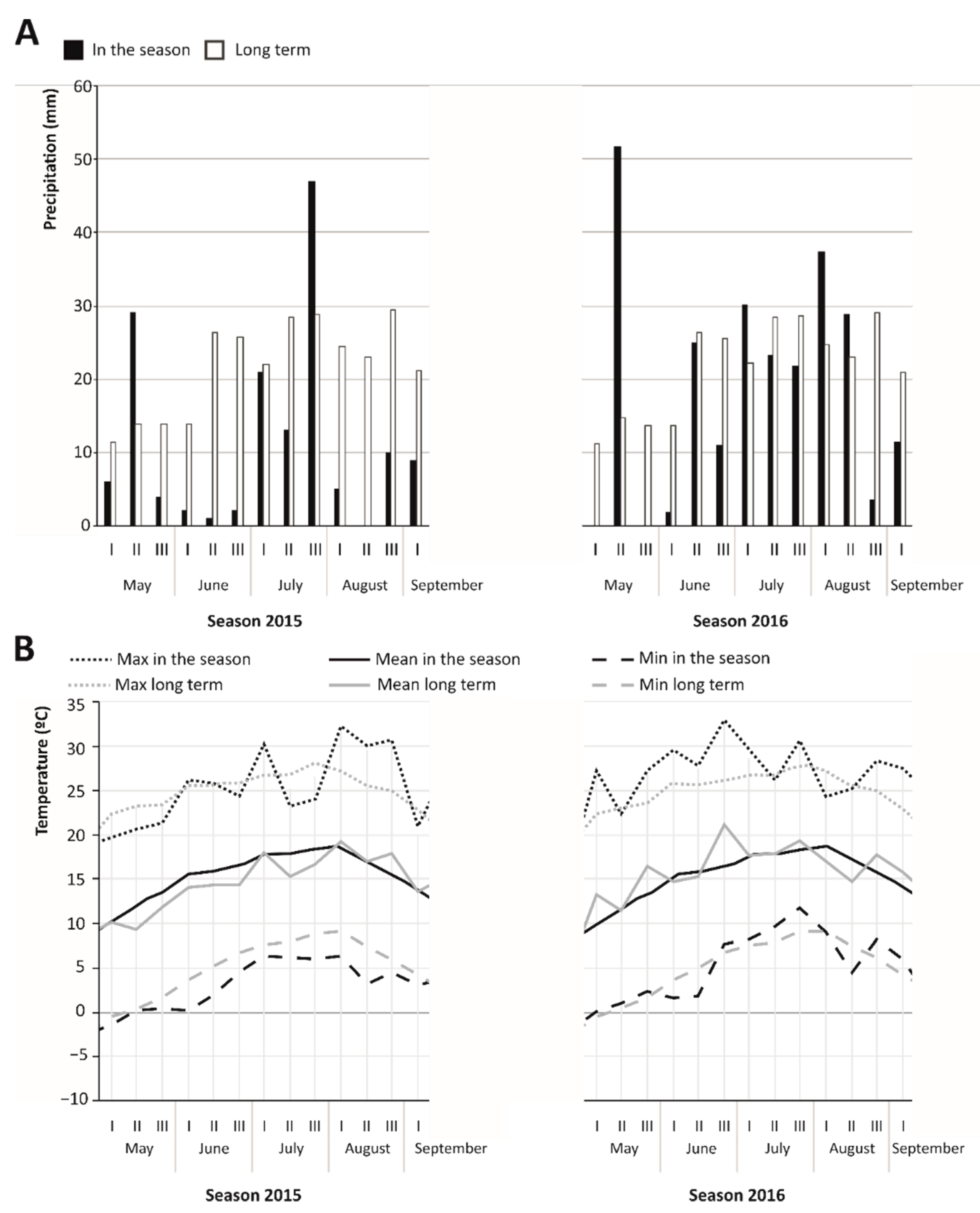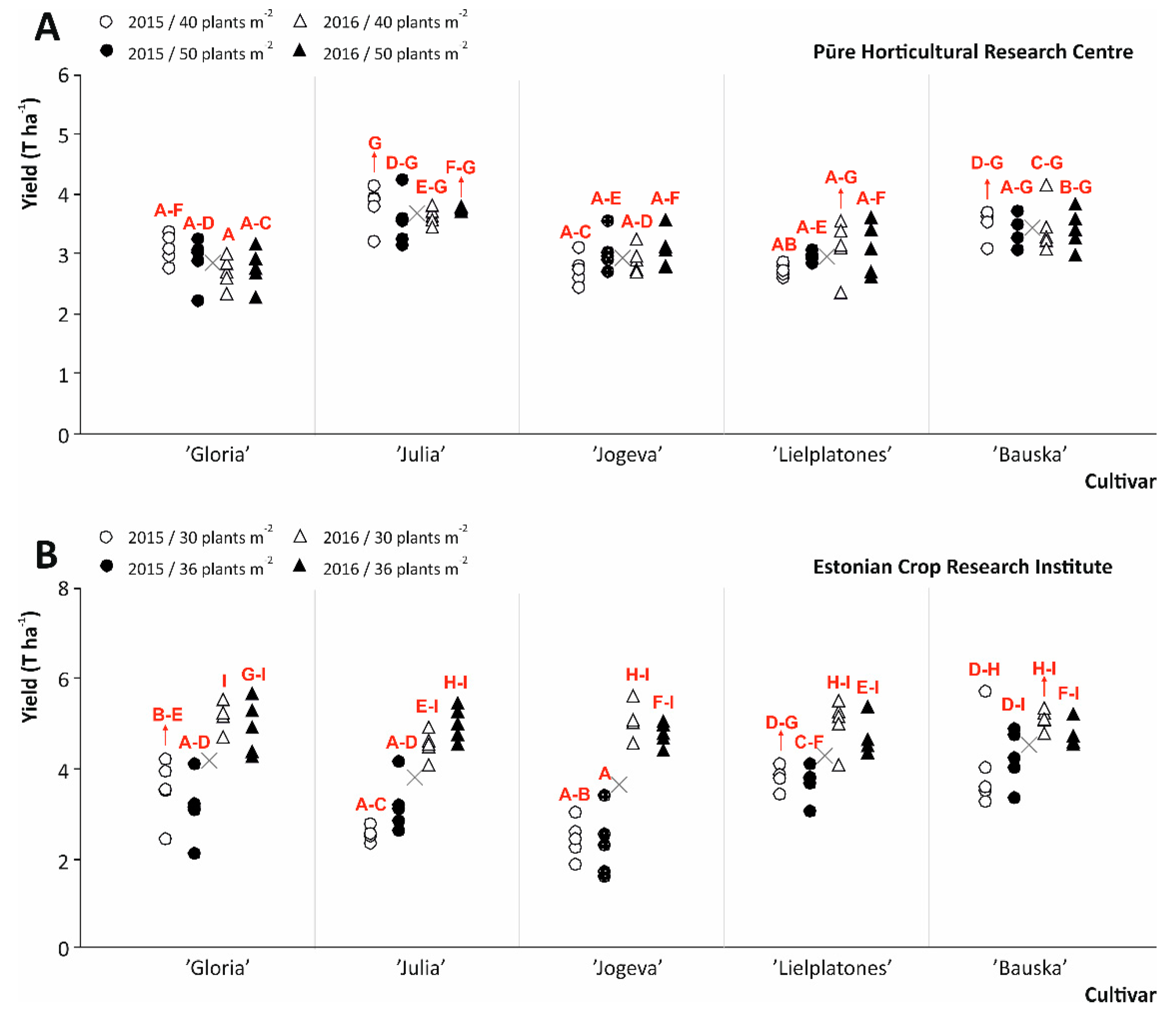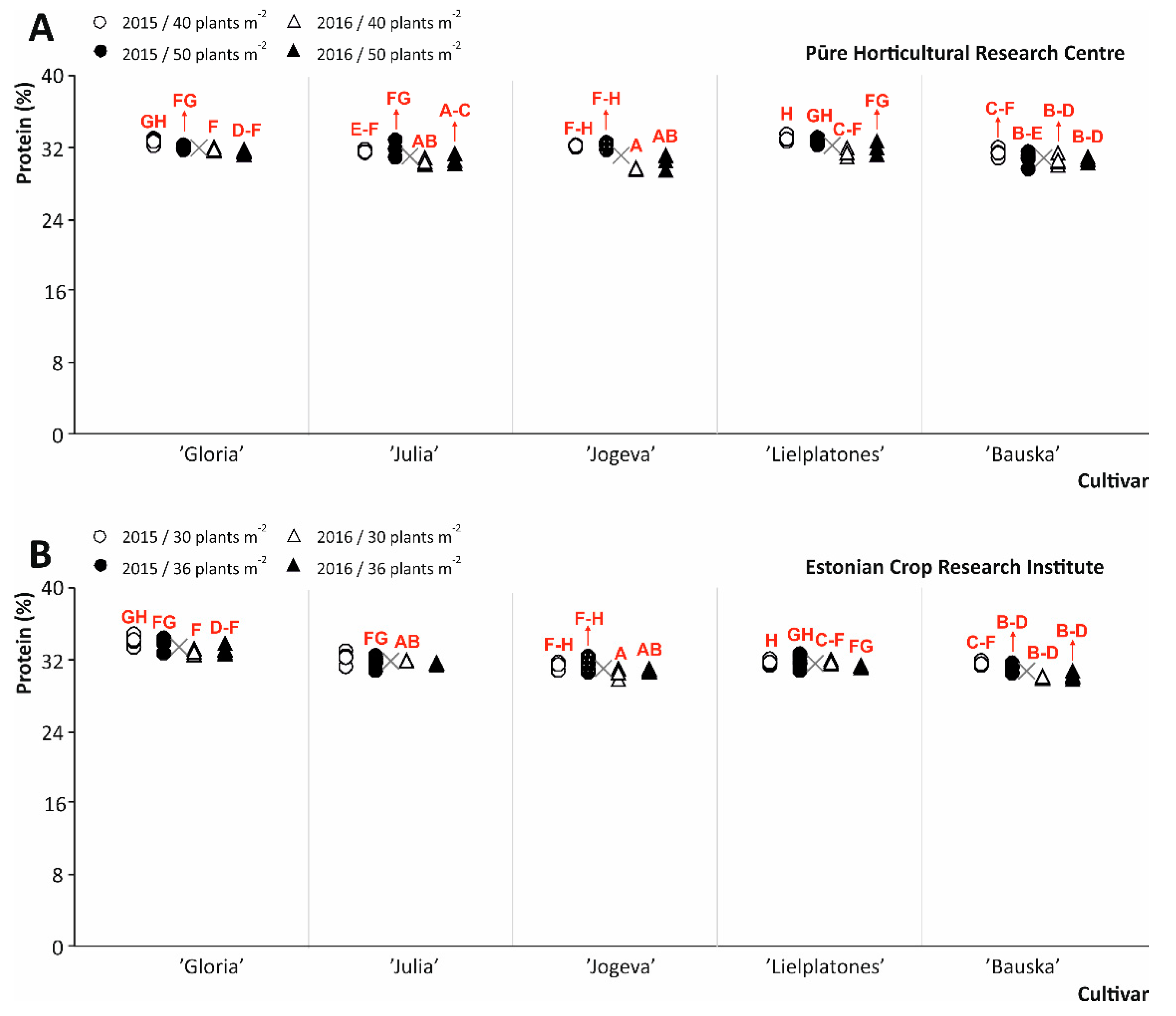Influence of Baltic Agro-Environmental Conditions on Yield and Quality of Fava Bean Crops in Conventional Systems
Abstract
:1. Introduction
2. Materials and Methods
2.1. Climatic Conditions
2.2. Crop Management, Site Characteristic, and Experimental Design
2.3. Measurements of Yield and Protein Content
2.4. Statistical Analysis
3. Results and Discussion
3.1. Meteorological Conditions and Plant Development
3.2. Plant Density Influence on Cultivar Yield and Quality Parameters
3.3. Plant Density Influence on Yield per Area and Plant Productivity
3.4. Economic Implications of Seeding Rate
3.5. Influence of Limited Precipitation on the Fava Bean Yield
4. Conclusions
Author Contributions
Funding
Institutional Review Board Statement
Informed Consent Statement
Conflicts of Interest
References
- Köpke, U.; Nemecek, T. Ecological services of faba bean. Field Crops Res. 2010, 115, 217–233. [Google Scholar] [CrossRef]
- Karkanis, A.; Ntatsi, G.; Lepse, L.; Fernández, J.A.; Vågen, I.M.; Rewald, B.; Alsiņa, I.; Kronberga, A.; Balliu, A.; Olle, M.; et al. Faba Bean Cultivation—Revealing Novel Managing Practices for More Sustainable and Competitive European Cropping Systems. Front. Plant Sci. 2018, 9, 1115. [Google Scholar] [CrossRef] [PubMed]
- Rodiño, A.P.; Santalla, M.; de Ron, A.M.; Drevon, J.J. Variability in symbiotic nitrogen fixation among white landracesof common bean from the Iberian peninsula. Symbiosis 2005, 40, 69–78. [Google Scholar]
- Duc, G.; Aleksić, J.M.; Marget, P.; Mikić, A.; Paull, J.; Redden, R.J.; Sass, O.; Stoddard, F.L.; Vandenberg, A.; Vishnyakova, M.; et al. Faba bean. In Grain Legumes; de Ron, A.M., Ed.; Springer Science+Business Media: New York, NY, USA, 2015; pp. 141–178. [Google Scholar]
- Jeuffroy, M.H.; Ney, B. Crop physiology and productivity. Field Crop Res. 1997, 53, 3–16. [Google Scholar] [CrossRef]
- Loss, S.P.; Siddique, K.H.M.; Jettner, R.; Martin, L.D. Responses of faba bean (Vicia faba L.) to sowing rate in south-western Australia I. Seed yield and economic optimum plant density. Aust. J. Agric. Res. 1997, 49, 989–997. [Google Scholar]
- Siddiqui, M.H.; Al-Khaishany, M.Y.; Al-Qutami, M.A.; Al-Whaibi, M.H.; Grover, A.; Ali, H.M.; Al-Wahibi, M.S.; Bukhari, N.A. Response of Different Genotypes of Faba Bean Plant to Drought Stress. Int. J. Mol. Sci. 2015, 16, 10214–10227. [Google Scholar] [CrossRef] [Green Version]
- Kumar, J.; Choudhary, A.K.; Solanki, R.K.; Pratap, A. Towards marker-assisted selection in pulses: A review. Plant Breed. 2011, 130, 297–313. [Google Scholar] [CrossRef]
- Weigelt, K.; Küster, H.; Radchuk, R.; Müller, M.; Weichert, H.; Fait, A.; Fernie, A.R.; Saalbach, I.; Weber, H. Increasing amino acid supply in pea embryos reveals specific interactions of N and C metabolism, and highlights the importance of mitochondrial metabolism. Plant J. 2008, 55, 909–926. [Google Scholar] [CrossRef]
- Confalone, A.; Lizaso, J.I.; Ruíz-Nogueira, B.; López-Cedrón, F.-X.; Sau, F. Growth, PAR use efficiency, and yield components of field-grown Vicia faba L. under different temperature and photoperiod regimes. Field Crops Res. 2010, 115, 140–148. [Google Scholar] [CrossRef]
- Lŏpez-Bellido, F.J.; Lŏpez-Bellido, L.; Lŏpez-Bellido, R.J. Competition, growth and yield of faba bean (Vicia faba L.). Eur. J. Agron. 2005, 23, 359–378. [Google Scholar] [CrossRef]
- Khan, J.; Paull, G.; Siddique, K.H.M.; Stoddard, F.L. Faba bean breeding for drought-affected environments: A physiological and agronomic perspective. Field Crops Res. 2010, 115, 279–286. [Google Scholar] [CrossRef]
- Matthews, P.; McCaffery, D.; Jenkins, L. Winter Crop Variety Sowing Guide 2015, Australia Region NSW DPI Management Guide; Grain Research & Development Corporation: Barton, Australia, 1997. [Google Scholar]
- Gezahegn, A.M.; Tesfaye, K.; Sharma, J.J.; Belel, M.D. Determination of optimum plant density for faba bean (Vicia faba L.) on vertisols at Haramaya, Eastern Ethiopia. Cogent Food Agric. 2016, 2, 1–10. [Google Scholar] [CrossRef]
- Bakry, B.A.; Elewa, T.A.; El-Karamany, M.F.; Zeidan, M.S.; Tawfik, M.M. Effect of row spacing on yield and its components of some faba bean varieties under newly reclaimed sandy soil condition. World J. Agric.Sc. 2010, 7, 68–72. [Google Scholar]
- Plūduma-Pauniņa, I.; Gaile, Z.; Bankina, B.; Balodis, R. Field Bean (Vicia faba L.) Yield and quality depending on some agrotechnical aspects. Agron. Res. 2018, 16, 212–220. [Google Scholar] [CrossRef]
- Turk, M.A.; Tawaha, A.R.M. Impact of seeding rate, seeding date, rate and method of phosphorus application in faba bean (Vicia faba L. minor) in the absence of moisture stress. Biotechnol. Agron. Soc. Environ. 2002, 6, 171–178. [Google Scholar]
- McVetty, P.B.E.; Evans, L.E.; Nugent-Rigby, J. Response of faba beans (Vicia faba L.) to seeding date and seeding rate. Can. J. Plant Sci. 1985, 66, 39–44. [Google Scholar] [CrossRef]
- McKee, T.B.; Doesken, N.J.; Kleist, J. The relationship of drought frequency and duration to time scales. In Proceedings of the 8th Conference on Applied Climatology, Boston, MA, USA, 17–22 January 1993; Volume 17, pp. 179–183. [Google Scholar]
- Meier, U. Growth Stages of Mono-and Dicotyledonous Plants; Blackwell Wissenschafts-Verlag: Oxford, UK, 1997. [Google Scholar]
- AOAC. Official Methods of Analysis, 16th ed.; Association of Official Analytical Chemists: Washington, DC, USA, 1995. [Google Scholar]
- Weyer, L.G. Near-Infrared Spectroscopy of Organic Substances. Appl. Spectrosc. Rev. 1985, 21, 1–43. [Google Scholar] [CrossRef]
- Machado, N.; Oppolzer, D.; Ramos, A.; Ferreira, L.; Rosa, E.A.; Rodrigues, M.; Barros, A.I. Evaluating the freezing impact on the proximate composition of immature cowpea (Vigna unguiculata L.) pods: Classical versus spectroscopic approaches. J. Sci. Food Agric. 2017, 97, 4295–4305. [Google Scholar] [CrossRef]
- Kulig, B.; Kolodziej, J.; Oleksy, A.; Kolodziejczyk, M.; Sajdak, A. Influence of the weather conditions on faba bean yielding. Ecol. Chem. Eng. 2011, 18, 1071–1078. [Google Scholar]
- Agriculture Victoria. Growing Faba Bean. 1994. Available online: http://agriculture.vic.gov.au/agriculture/grains-and-other-crops/crop-production/growing-faba-bean/ (accessed on 18 April 2021).
- Zabawi, A.G.; Dannetti, M.D.D. Responses of faba bean (Vicia faba) to different levels of plant available water: I. Phenology, growth and biomass partitioning. J. Trop. Agric. Food Sci. 2010, 38, 11–19. [Google Scholar]
- OECD-FAO. Agricultural Outlook, 2013–2022: Highlights © OECD/FAO. 2013. Available online: https://www.oecd.org/berlin/OECD-FAO%20Highlights_FINAL_with_Covers%20(3).pdf (accessed on 18 October 2021).
- Duc, G. Faba bean (Vicia faba L.). Field Crops Res. 1997, 53, 99–109. [Google Scholar] [CrossRef]
- Bodner, G.; Kronberga, A.; Lepse, L.; Olle, M.; Vågen, I.M.; Rabante, L.; Fernández, J.A.; Ntatsi, G.; Balliu, A.; Rewald, B. Trait identification of faba bean ideotypes for Northern European environments. Eur. J. Agron. 2018, 96, 1–12. [Google Scholar] [CrossRef]
- Lizarazo, C.I.; Lampi, A.M.; Liu, J.; Sontag-Strohm, T.; Piironenb, V.; Stoddard, F.L. Nutritive quality and protein production from grain legumes in a boreal climate. J. Sci. Food Agric. 2015, 95, 2053–2064. [Google Scholar] [CrossRef] [Green Version]
- Metayer, N. Vicia Faba Breeding for Sustainable Agriculture in Europe; Feverole, G., Ed.; Eufaba; University of Cordoba: Córdoba, Spain, 2004; pp. 1–17. [Google Scholar]
- Matthews, P.W.; Armstrong, E.L.; Lisle, C.J.; Menz, I.D.; Shephard, P.L.; Armstrong, B.C. The effect of faba bean plant population on yield, seed quality and plant architecture under irrigation in southern NSW. Aust. Crop. Agron. J. 2008, 23, 40–43. [Google Scholar]
- Fleury, D. Optimal Seeding Rates for Fababean Seed Size. TopCrop Manager. 2018. Available online: https://www.topcropmanager.com/optimal-seeding-rates-for-fababean-seed-size-21068/ (accessed on 18 October 2021).
- Graf, R.J.; Rowland, G.G. Effect of plant density on yield and components of yield of faba bean. Can. J. Plant Sci. 1987, 67, 1–10. [Google Scholar] [CrossRef]
- Ruggiero, C.; de Pascale, S.; Fagnano, M. Plant and soil resistance to water flow in faba bean (Vicia faba L. major Harz.). Plant Soil 1999, 210, 219–231. [Google Scholar] [CrossRef]





| Month | Decade | PHRC | ECRI | ||
|---|---|---|---|---|---|
| 2015 | 2016 | 2015 | 2016 | ||
| May | I | −0.77 | −1.62 | 2.24 | −1.72 |
| II | 2.15 | 5.36 | −1.75 | −2.34 | |
| III | −1.42 | −1.97 | −1.35 | −2.52 | |
| June | I | −1.72 | −1.72 | −1.70 | −0.86 |
| II | −3.64 | −0.19 | −2.67 | 13.24 | |
| III | −3.41 | −2.09 | 0.33 | −0.10 | |
| July | I | −0.16 | 1.14 | −0.13 | 4.61 |
| II | −2.22 | −0.75 | 1.35 | −1.85 | |
| III | 2.61 | −0.99 | −1.01 | −2.43 | |
| August | I | −2.81 | 1.81 | −3.32 | 5.14 |
| II | −3.30 | 0.83 | −3.33 | 6.61 | |
| III | −2.79 | −3.70 | −2.15 | 1.14 | |
| September | I | −1.73 | −1.38 | 4.06 | −1.13 |
| Parameter | Season | ||||
|---|---|---|---|---|---|
| 2015 | 2016 | ||||
| ECRI | PHRC | ECRI | PHRC | ||
| Soil (plot) preparation before sowing | Ploughing autumn 2015. Cultivation 2 times before sowing. | Ploughing autumn 2015. Cultivation 2 times. | Ploughing autumn 2016. Cultivation 2 times before sowing. | Ploughing autumn 2016. Cultivation 2 times before sowing. | |
| Sowing date | 5 May 2016 | 8 May 2015 | 5 May 2016 | 9 May 2016 | |
| Sowing depth (cm) | 4 | 4 | 4 | 4 | |
| Humus content (g kg−1) | 30.7 | 31.0 | 34.6 | 34.6 | |
| Soil type | Calcaric cambisoil | Soddy-calcarous podzolic | |||
| Soil texture | Sandy loam | Sandy loam | |||
| Plant available P in soil (mg kg−1) | 67.7 | 127.6 | 59.6 | 127.6 | |
| Plant available K in soil (mg kg−1) | 98.7 | 105.9 | 107.4 | 105.9 | |
| pHKCl | 6.32 | 6.27 | 6.31 | 6.20 | |
| Preceding crop | Barley | Perennial grasses | Oat | Perennial grasses | |
| Fertilization | Type | N:P:K (5:10:25) | N:P:K (10:10:20) | N:P:K (7:12:25) | N:P:K (10:10:20) |
| Amount (kg ha−1) | 300 | 300 | 300 | 300 | |
| Pest management | - | Decis Mega (deltametrin 50 g L−1) 150 Ml ha−1 (twice) | - | Decis Mega (deltametrin 50 g L−1) 150 mL ha−1. Actara (tiametoksam 250 g kg−1) 0.08 kg ha−1. | |
| Weds management | Stomp (455 g L−1 pendimathalin) 1.5 L ha−1; Basagran (bentazon 480 g L−1) 1.5 L ha−1. Hand weeding | Hand weeding | Activus 330 (pendimethalin 330 g L−1) EC 3 L ha−1 + Basagran 480 (bentazon 480 g L−1) 1.5 L ha−1 | Hand weeding | |
| Location | ECRI | PHRC | ||||
|---|---|---|---|---|---|---|
| Parameter | Estimates of the Variance Components | Z Value | Pr > Z | Estimates of the Variance Components | Z Value | Pr > Z |
| Yield | ||||||
| Year | 1.2637 | 0.6900 | 0.2466 | 0.0000 | --- Z | --- |
| Block (year) | 0.1304 | 1.4000 | 0.0808 | 0.0000 | --- | --- |
| Residual | 0.3066 | 5.6100 | <0.0001 | 0.1188 | 5.9200 | <0.0001 |
| Protein content | ||||||
| Year | 0.2560 | 0.6200 | 0.2682 | 0.6595 | 0.7000 | 0.2423 |
| Block (year) | 0.1281 | 1.5200 | 0.0642 | 0.0000 | --- | --- |
| Residual | 0.1770 | 5.6100 | <0.0001 | 0.3051 | 5.8700 | <0.0001 |
| Factor Z | Degrees of Freedom | Yield | Protein Concentration | ||||||||||
|---|---|---|---|---|---|---|---|---|---|---|---|---|---|
| ECRI | PHRC | ECRI | PHRC | ||||||||||
| Effect Y | F Value | p-Value | Effect | F Value | p-Value | Effect | F Value | p-Value | Effect | F Value | p-Value | ||
| C | 4 | *** | 6.74 | 0.0001 | *** | 18.19 | <0.0001 | *** | 102.65 | <0.0001 | *** | 19.53 | <0.0001 |
| D | 1 | N.s. | 0.29 | 0.5894 | N.s. | 0.08 | 0.7845 | N.s. | 1.65 | 0.2035 | N.s. | 0.00 | 0.9759 |
| C × D | 4 | N.s. | 1.68 | 0.1646 | N.s. | 0.63 | 0.6445 | N.s. | 0.86 | 0.4943 | N.s. | 2.00 | 0.1049 |
Publisher’s Note: MDPI stays neutral with regard to jurisdictional claims in published maps and institutional affiliations. |
© 2021 by the authors. Licensee MDPI, Basel, Switzerland. This article is an open access article distributed under the terms and conditions of the Creative Commons Attribution (CC BY) license (https://creativecommons.org/licenses/by/4.0/).
Share and Cite
Lepse, L.; Vågen, I.M.; Zeipina, S.; Torp, T.; Olle, M.; Rosa, E.; Domínguez-Perles, R. Influence of Baltic Agro-Environmental Conditions on Yield and Quality of Fava Bean Crops in Conventional Systems. Agriculture 2021, 11, 1042. https://doi.org/10.3390/agriculture11111042
Lepse L, Vågen IM, Zeipina S, Torp T, Olle M, Rosa E, Domínguez-Perles R. Influence of Baltic Agro-Environmental Conditions on Yield and Quality of Fava Bean Crops in Conventional Systems. Agriculture. 2021; 11(11):1042. https://doi.org/10.3390/agriculture11111042
Chicago/Turabian StyleLepse, Liga, Ingunn M. Vågen, Solvita Zeipina, Torfinn Torp, Margit Olle, Eduardo Rosa, and Raul Domínguez-Perles. 2021. "Influence of Baltic Agro-Environmental Conditions on Yield and Quality of Fava Bean Crops in Conventional Systems" Agriculture 11, no. 11: 1042. https://doi.org/10.3390/agriculture11111042
APA StyleLepse, L., Vågen, I. M., Zeipina, S., Torp, T., Olle, M., Rosa, E., & Domínguez-Perles, R. (2021). Influence of Baltic Agro-Environmental Conditions on Yield and Quality of Fava Bean Crops in Conventional Systems. Agriculture, 11(11), 1042. https://doi.org/10.3390/agriculture11111042






